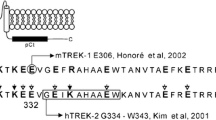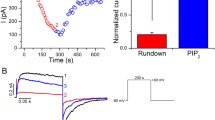Abstract
TWIK-related two-pore domain K+ channels 1 and 2 (TREKs) are activated under various physicochemical conditions. However, the directions in which they are regulated by PI(4,5)P2 and intracellular ATP are not clearly presented yet. In this study, we investigated the effects of ATP and PI(4,5)P2 on overexpressed TREKs (HEK293T and COS-7) and endogenously expressed TREK-2 (mouse astrocytes and WEHI-231 B cells). In all of these cells, both TREK-1 and TREK-2 currents were spontaneously increased by dialysis with ATP-free pipette solution for whole-cell recording (ITREK-1,w-c and ITREK-2w-c) or by membrane excision for inside-out patch clamping without ATP (ITREK-1,i-o and ITREK-2,i-o). Steady state ITREK-2,i-o was reversibly decreased by 3 mM ATP applied to the cytoplasmic side, and this reduction was prevented by wortmannin, a PI-kinase inhibitor. An exogenous application of PI(4,5)P2 inhibited the spontaneously increased ITREKs,i-o, suggesting that intrinsic PI(4,5)P2 maintained by intracellular ATP and PI kinase may set the basal activity of TREKs in the intact cells. The inhibition of intrinsic TREK-2 by ATP was more prominent in WEHI-231 cells than astrocytes. Interestingly, unspecific screening of negative charges by poly-L-lysine also inhibited ITREK-2,i-o. Application of PI(4,5)P2 after the poly-L-lysine treatment showed dose-dependent dual effects, initial activation and subsequent inhibition of ITREK-2,i-o at low and high concentrations, respectively. In HEK293T cells coexpressing TREK-2 and a voltage-sensitive PI(4,5)P2 phosphatase, sustained depolarization increased ITREK-2,w-c initially (<5 s) but then decreased the current below the control level. In HEK293T cells coexpressing TREK-2 and type 3 muscarinic receptor, application of carbachol induced transient activation and sustained suppression of ITREK-2,w-c and cell-attached ITREK-2. The inhibition of TREK-2 by unspecific electrostatic quenching, extensive dephosphorylation, or sustained hydrolysis of PI(4,5)P2 suggests the existence of dual regulatory modes that depend on PI(4,5)P2 concentration.







Similar content being viewed by others
References
Bang H, Kim Y, Kim D (2000) TREK-2, a new member of the mechanosensitive tandem-pore K+ channel family. J Biol Chem 275(23):17412–17419
Bista P, Pawlowski M, Cerina M, Ehling P, Leist M, Meuth P, Aissaoui A, Borsotto M, Heurteaux C, Decher N, Pape HC, Oliver D, Meuth SG, Budde T (2015) Differential phospholipase C-dependent modulation of TASK and TREK two-pore domain K+ channels in rat thalamocortical relay neurons. J Physiol 593(1):127–144
Chemin J, Patel AJ, Delmas P, Sachs F, Lazdunski M, Honore E (2007) Regulation of the mechano-gated K2P channel TREK-1 by membrane phospholipids. Curr Top Membr 59:155–170
Chemin J, Patel AJ, Duprat F, Lauritzen I, Lazdunski M, Honoré E (2005) A phospholipid sensor controls mechanogating of the K+ channel TREK-1. EMBO J 24(1):44–53
Chemin J, Patel AJ, Duprat F, Sachs F, Lazdunski M, Honore E (2007) Up- and down-regulation of the mechano-gated K(2P) channel TREK-1 by PIP (2) and other membrane phospholipids. Pflugers Arch 455(1):97–103
Enyeart JJ (2005) Biochemical and ionic signaling mechanisms for ACTH-stimulated cortisol production. Vitam Horm 70:265–279
Enyeart JJ, Xu L, Danthi S, Enyeart JA (2002) An ACTH- and ATP-regulated background K+ channel in adrenocortical cells is TREK-1. J Biol Chem 277(51):49186–49199
Enyedi P, Czirják G (2010) Molecular background of leak K+ currents: two-pore domain potassium channels. Physiol Rev 90(2):559–605. doi:10.1152/physrev.00029.2009
Gnatenco C, Han J, Snyder AK, Kim D (2002) Functional expression of TREK-2 K+ channel in cultured rat brain astrocytes. Brain Res 931(1):56–67
Hille B, Dickson EJ, Kruse M, Vivas O, Suh BC (2015) Phosphoinositides regulate ion channels. Biochim Biophys Acta 1851(6):844–856
Honoré E (2007) The neuronal background K2P channels: focus on TREK1. Nat Rev Neurosci 8(4):251–261
Hossain MI, Iwasaki H, Okochi Y, Chahine M, Higashijima S, Nagayama K et al (2008) Enzyme domain affects the movement of the voltage sensor in ascidian and zebrafish voltage-sensing phosphatases. J Biol Chem 283:18248–18259
Hwang EM, Kim E, Yarishkin O, Woo DH, Han KS, Park N, Bae Y, Woo J, Kim D, Park M, Lee CJ, Park JY (2014) A disulphide-linked heterodimer of TWIK-1 and TREK-1 mediates passive conductance in astrocytes. Nat Commun 5:3227
Kang D, Choe C, Cavanaugh E, Kim D (2007) Properties of single two-pore domain TREK-2 channels expressed in mammalian cells. J Physiol 583(Pt 1):57–69
Kang D, Han J, Kim D (2006) Mechanism of inhibition of TREK-2 (K2P10.1) by the Gq-coupled M3 muscarinic receptor. Am J Physiol Cell Physiol 291(4):C649–C656
Kim SJ, Nam JH. (2010) Mechanosensitive K+ channels in mouse B lymphocytes: PLC-mediated release of TREK-2 from inhibition by PIP2. In: Kamkin A, Kiseleva I (eds) Mechanosensitivity and mechanotransduction, Volume 4 of the series Mechanosensitivity in Cells and Tissues. Springer, Netherlands, pp 353–368
Lauritzen I, Chemin J, Honoré E, Jodar M, Guy N, Lazdunski M, Patel AJ (2005) Cross-talk between the mechano-gated K2P channel TREK-1 and the actin cytoskeleton. EMBO Rep 6:642–648
Lesage F, Lazdunski M (2000) Molecular and functional properties of two-pore-domain potassium channels. Am J Physiol Ren Physiol 279(5):F793–F801
Liu H, Enyeart JA, Enyeart JJ (2007) Angiotensin II inhibits native bTREK-1 K+ channels through a PLC-, kinase C-, and PI(4,5)P2-independent pathway requiring ATP hydrolysis. Am J Physiol Cell Physiol 293(2):C682–C695
Lopes CM, Remon JI, Matavel A, Sui JL, Keselman I, Medei E, Shen Y, Rosenhouse-Dantsker A, Rohacs T, Logothetis DE (2007) Protein kinase A modulates PLC-dependent regulation and PI(4,5)P2-sensitivity of K+ channels. Channels (Austin) 1(2):124–134
Lopes CM, Rohács T, Czirják G, Balla T, Enyedi P, Logothetis DE (2005) PI(4,5)P2 hydrolysis underlies agonist-induced inhibition and regulates voltage gating of two-pore domain K+ channels. J Physiol 564(Pt 1):117–129
Maingret F, Patel AJ, Lesage F, Lazdunski M, Honoré E (1999) Mechano- or acid stimulation, two interactive modes of activation of the TREK-1 potassium channel. J Biol Chem 274(38):26691–26696
Mathie A (2007) Neuronal two-pore-domain potassium channels and their regulation by G protein-coupled receptors. J Physiol 578(Pt 2):377–385
Mori MX, Inoue R (2014) New experimental trends for phosphoinositides research on ion transporter/channel regulation. J Pharmacol Sci 126(3):186–197
Murata Y, Iwasaki H, Sasaki M, Inaba K, Okamura Y (2005) Phosphoinositide phosphatase activity coupled to an intrinsic voltage sensor. Nature 435:1239–1243
Nam JH, Lee HS, Nguyen YH, Kang TM, Lee SW, Kim HY, Kim SJ, Earm YE, Kim SJ (2007) Mechanosensitive activation of K+ channel via phospholipase C-induced depletion of phosphatidylinositol 4,5-bisphosphate in B lymphocytes. J Physiol 582(Pt 3):977–990
Nam JH, Woo JE, Uhm DY, Kim SJ (2004) Membrane-delimited regulation of novel background K+ channels by MgATP in murine immature B cells. J Biol Chem 279(20):20643–20654
Noël J, Sandoz G, Lesage F (2011) Molecular regulations governing TREK and TRAAK channel functions. Channels (Austin) 5(5):402–409
Patel AJ, Honoré E, Maingret F, Lesage F, Fink M, Duprat F, Lazdunski M (1998) A mammalian two pore domain mechano-gated S-like K+ channel. EMBO J 17(15):4283–4290
Rivas-Ramírez P, Cadaveira-Mosquera A, Lamas JA, Reboreda A (2015) Muscarinic modulation of TREK currents in mouse sympathetic superior cervical ganglion neurons. Eur J Neurosci 42:1797–1807
Sandoz G, Bell SC, Isacoff EY (2011) Optical probing of a dynamic membrane interaction that regulates the TREK1 channel. Proc Natl Acad Sci U S A 108:2605–2610
Sandoz G, Douguet D, Chatelain F, Lazdunski M, Lesage F (2009) Extracellular acidification exerts opposite actions on TREK1 and TREK2 potassium channels via a single conserved histidine residue. Proc Natl Acad Sci U S A 106:14628–14633
Segal-Hayoun Y, Cohen A, Zilberberg N (2010) Molecular mechanisms underlying membrane-potential-mediated regulation of neuronal K2P2.1 channels. Mol Cell Neurosci 43(1):117–126
Suh BC, Hille B (2008) PIP2 is a necessary cofactor for ion channel function: how and why? Annu Rev Biophys 37:175–195
Zheng H, Nam JH, Nguen YH, Kang TM, Kim TJ, Earm YE, Kim SJ (2008) Arachidonic acid-induced activation of large-conductance potassium channels and membrane hyperpolarization in mouse B cells. Pflugers Arch 456(5):867–881
Zheng H, Nam JH, Pang B, Shin DH, Kim JS, Chun YS, Park JW, Bang H, Kim WK, Earm YE, Kim SJ (2009) Identification of the large-conductance background K+ channel in mouse B cells as TREK-2. Am J Physiol Cell Physiol 297(1):C188–C197
Zhuo RG, Liu XY, Zhang SZ, Wei XL, Zheng JQ, Xu JP, Ma XY (2015) Insights into the stimulatory mechanism of 2-aminoethoxydiphenyl borate on TREK-2 potassium channel. Neuroscience 300:85–93
Acknowledgments
This work was supported by a National Research Foundation of Korea (NRF) grant funded by the Korean government (MSIP; Nos. 2007–0056092 and 2011–0017370) and by the Education and Research Encouragement Fund from Seoul National University Hospital (2016).
Author information
Authors and Affiliations
Corresponding author
Rights and permissions
About this article
Cite this article
Woo, J., Shin, D.H., Kim, H.J. et al. Inhibition of TREK-2 K+ channels by PI(4,5)P2: an intrinsic mode of regulation by intracellular ATP via phosphatidylinositol kinase. Pflugers Arch - Eur J Physiol 468, 1389–1402 (2016). https://doi.org/10.1007/s00424-016-1847-0
Received:
Revised:
Accepted:
Published:
Issue Date:
DOI: https://doi.org/10.1007/s00424-016-1847-0




